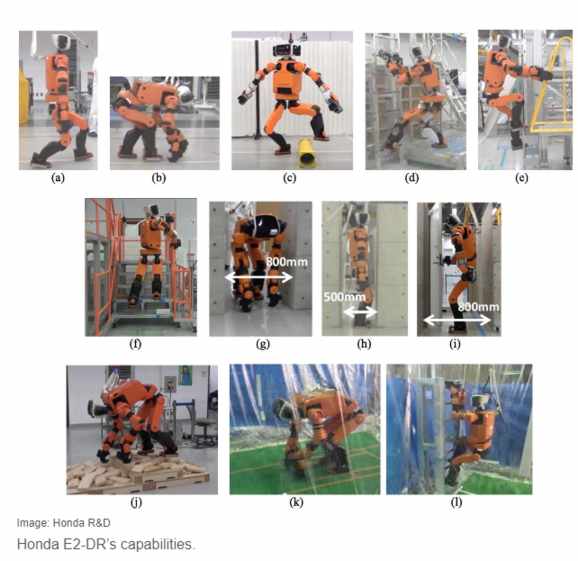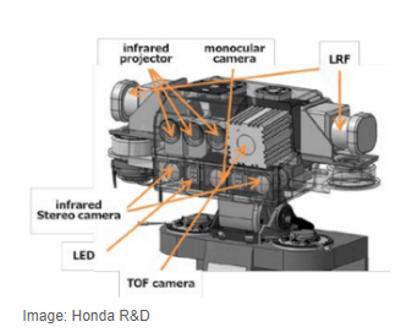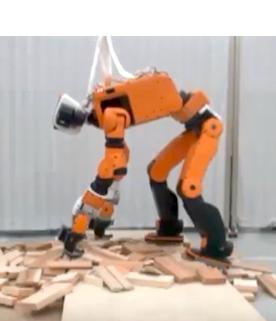| Honda's Disaster Response Robot |
| Written by Sue Gee | |||
| Sunday, 08 October 2017 | |||
|
Honda's E2-DR prototype described as an "experimental legged robot for inspection and disaster response in plants" was revealed at last month's IROS 2017 in Vancouver. Given the impetus of the March 2011 earthquake and tsunami that crippled Japan's Fukushima nuclear plant, it is not surprising that Honda is working on a robot that could be deployed in disaster scenarios. Honda's humanoid robot, ASIMO originally made its debut in October 2000 and for at least four years the company has been designing a more robust and practical version. Now Honda's progress with E2-DR have been presented to this year's International Conference on Robots and Systems (IROS 2017) with this video:
More details of its specification and capabilities are available in Development of Experimental Legged Robot for Inspection and Disaster Response in Plants by Takahide Yoshiike, Mitsuhide Kuroda, Ryuma Ujino, Hiroyuki Kaneko, Hirofumi Higuchi, Shingo Iwasaki, Yoshiki Kanemoto, Minami Asatani, and Takeshi Koshiishi from Honda R&D. E2-DR is 1.68 meters high and weighs 85 kilograms, which includes a 1000-Wh lithion-ion battery which provides for 90-minute operating time. At only 25 cm “thick,” it can squeeze through 30-cm gaps, a size which Honda specified because factories often have “shortcut” passages of about that width that can be used to get around blocked corridors. To make it suitable for use in a disaster, E2-DR has been made dustproof, splashproof and able to operate between -10 and 40 °C. However, this doesn't make it proof against a nuclear incident - no electronics is ever likely to be able to withstand conditions such as those in Fukushima. Honda's wish list of functional capabilities for robot that can be deployed for inspection, maintenance and as a first responder in disasters in "social infrastructures such as plants" are:
So far E2-DR has achieved: (a) Bipedal walking at 4 km/h On its head, E2-DR is equipped with two rotating Hokuyo laser rangefinders, a monocular camera with a synchronized LED flash, a SR4000 time of flight camera, and a stereo camera coupled to an infrared light projector. There are also cameras and a 3D sensor on each of the hands. E2-DR has a total of 33 degrees of freedom, including 8 DoFs per arm, 6 DoFs per leg, 2 for its torso, and 1 for hands and head. To climb steep stairs it uses the same approach, of rotating its torso 180 degrees, as the South Korean DRC-HUBO robot that won the DARPA Robotics Challenge in 2015. And had today's E2-DR taken part back then it might well have emerged the victor. Or would it have fallen over, which was the fate of almost all the robot contestants? Although work is ongoing to teach E2-DR to handle collisions, you'll notice that it is tethered on a harness in the video, which begs the question of whether such expensive kit be would ever be deployed in an emergency situation where it would likely suffer damage. Honda's ASIMO is available commercially - at a price tag of at least US $2.5 million, making it the most expensive advanced humanoid robot on the market. We have seen many robot formats proposed for rescue situations including snakes and drones with multi-armed wheeled robots being the ones most capable of moving victims. The built environment, however, has been designed for the human form factor. Switches, levers and other controls tend to be placed at a convenient height for arms; legs are required for stairs, ladders and negotiating around barriers. So there is a strong case for needing, adult-sized, humanoid robots but I doubt they will ever be inexpensive enough to be considered disposable. More InformationHonda Unveils Prototype E2-DR Disaster Response Robot (IEEE Spectrum) Related ArticlesASIMO Celebrates 10th Anniversary (2010) Robot Fear Of Falling - South Koreans Win DARPA Robotics Challenge Darpa Robotics Challenge Grows Google's Schaft Wins DARPA Robotics LineFORM A New Use For A Robot To be informed about new articles on I Programmer, sign up for our weekly newsletter, subscribe to the RSS feed and follow us on Twitter, Facebook or Linkedin.
Comments
or email your comment to: comments@i-programmer.info
|
|||
| Last Updated ( Sunday, 08 October 2017 ) |




